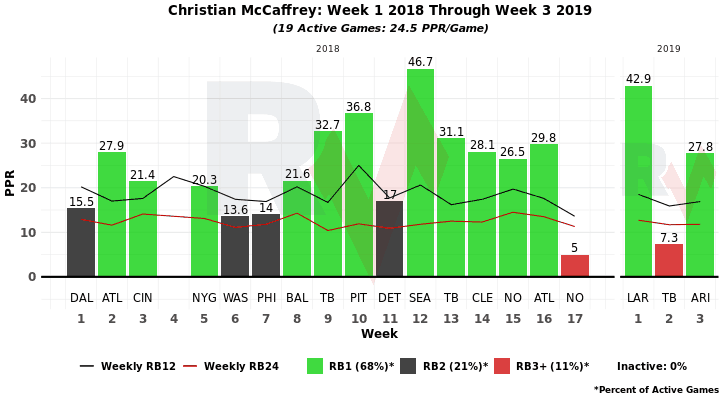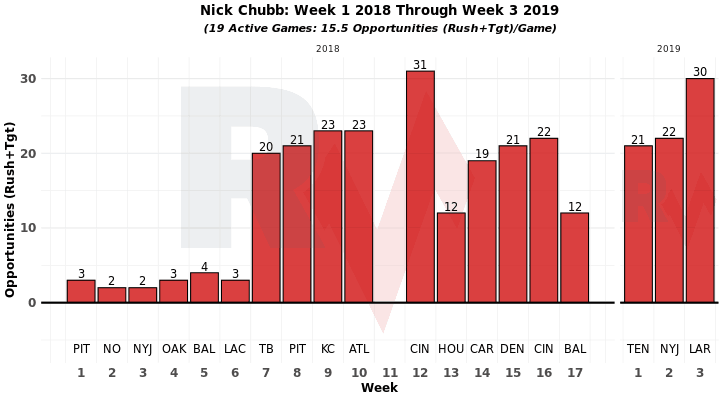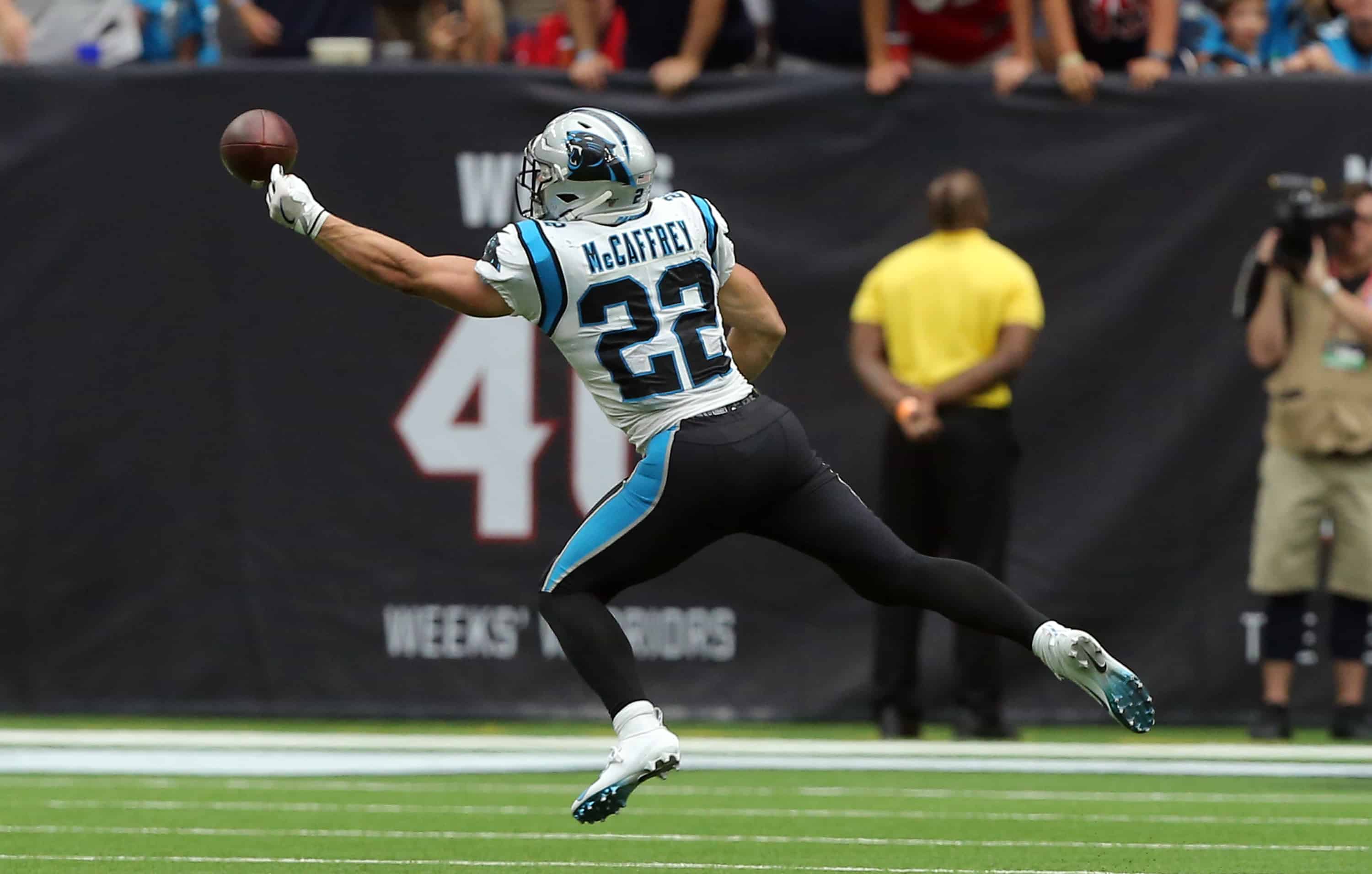Week 4 provided numerous examples of why opportunity is more important than efficiency, and how game-script can greatly impact that opportunity. With just Monday Night Football left to go, there have been 10 underdogs who kept it close enough to cover the spread, including eight who won outright. How does this come into play for fantasy? Because big plays and touchdowns are hard to predict, but how many touches a player gets can be more easily projected, especially at running back.
I’ll start with Christian McCaffrey who had nearly 34 points in PPR. This is his third game so far this year with over 27 points. He is talented and showed as much on the pass he tipped to himself for a diving catch. But what is best about McCaffrey for fantasy is his consistent bell-cow usage. In their week two loss when Cam Newton was starting, he had a season-low 18 touches. With the young quarterback Kyle Allen starting, Carolina went back to feeding CMC as he had 27 touches last week and an astounding 37 touches this week. He had 10 receptions for over 80 yards for the second time this year, giving him frequent WR1 numbers to go with his rushing average of a TD and 102.75 rushing YPG. Why so many touches this week? The Panthers never trailed the entire game. They have an inexperienced QB, and teams with a lead are more likely to run the ball to keep the clock moving.

While the situation buoyed McCaffrey’s fantasy day, it had the opposite effect for the Panthers’ passing weapons. Subtracting CMC’s receptions and receiving yards, there were only 14 catches for 146 yards to go around for WR’s DJ Moore (7.4 points) and Curtis Samuel (6.3), plus Greg Olsen (2.5) at TE. In a close, low-scoring game, or when playing with a lead, we can see how it can be a boon for the RB1 but detrimental to the passing game.

Finishing above CMC for the top RB spot this week was Nick Chubb, the Browns’ lead back. After playing 97% of the snaps last week, there was talk from the coaching staff about reducing his usage a bit. He also was perceived to be in a tough spot, as a seven-point road underdog in a division matchup against the vaunted Ravens defense (12th DVOA vs the rush through three weeks). These had me a bit worried, but turned out to be irrelevant, as Chubb was given his regular workload with 20 carries and three receptions.

The difference this week was that he jumped from 4 YPC up to 8.2 YPC, largely thanks to his league-long 88-yard TD rush. He added two other rushing TDs and 18 yards receiving, good for 39.3 points. The Browns lead for most of this matchup, which didn’t lead to extra touches, but it kept them from having to abandon the run. Chubb has been a lead back with consistent opportunity all year, this just happened to be the week where he erupted.

Although not third on the week, I do want to point out Leonard Fournette’s Week 4 stat line of 29/255/0 with two receptions for 20 yards. This could easily be mistaken as a bad QB performance. Instead, we have the culmination of a heavily utilized, lead RB, finally achieving a strong YPC. The Jaguars hadn’t had a 100-yard rusher since Week 14 of 2017, but regression hit in a big way as Fournette rushed for over three times his average. Up until this game, he had been a huge disappointment from a production and efficiency standpoint.
In spite of getting the seventh most RB opportunities in the league and ranking sixth in Expected Points per game (EP/Gm), he ranked down at 18th in points per game. He ranked 103rd of all RBs in his Fantasy Points Over Expectations (FPOE), with -3.4 FPOE per game, meaning through three weeks he had averaged 3.4 fewer points than his usage would project. Perhaps his offensive line was not blocking well, or perhaps he is not a great running back, but he had averaged 21 opportunities per game and it had increased by two in each week so far. When players who get a large workload don’t perform, it can be frustrating, but when the opportunity comes the points should eventually follow.

As for WRs, the top two producers came from opposite sides of the Buccaneers vs Rams game. Where in the first week, we saw players such John Ross and Marquise Brown with outlier scores on 7 or fewer receptions, this week’s WR’s got there with the help of abundant targets and receptions.
At the top is Tampa Bay’s Chris Godwin, who earned a 96th-percentile Sparq-X score and is in the midst of a third-year breakout. Godwin went 12/172/2 on 14 targets, good for 41.2 points, the top overall score at any position. He is part of perhaps the top receiving duo in the league, with Mike Evans on the outside. Godwin won’t be the 1A option on his team every week, but he is a WR1 with a decent floor and huge upside. He has caught a touchdown in three of four games and has gone over 100 yards twice. As long as Jameis Winston is producing, Godwin should continue to post strong numbers.

On the other side, there was Robert Woods, the beneficiary of the Rams being down 21 points to start and never taking the lead. Jared Goff threw two interceptions early and three total, which forced his team to chase points with a pass-heavy strategy. This led to over 500 yards passing, which helped Woods to 13/164/0 for 29.4 points on 15 targets.
This was a great performance, especially considering he got there on receptions and yardage alone. The 11.8-point gap between Woods and Godwin really highlights how red-zone usage can make a difference. I like to use WRs who are consistently targeted and rarely drop passes; notice both guys only left two passes on the table with a catch rate of at least 85.7%.
WRs are inherently more volatile than RBs, but pass-catchers like these tend to have a safer floor than those who live and die by the deep ball, yet they are still able to pop-off for outlier weeks. I do prefer Godwin to Woods though, due to Woods’s production being less consistent thanks to sharing the field with other strong receivers in Cooper Kupp and Brandon Cooks.

There were some other RBs and WRs who had strong days on less volume thanks to TD variance swinging their way, including Jordan Howard (3 TDs on 18 touches), Todd Gurley (2 on 12), A.J. Brown (2 on 3), Courtland Sutton (2 on 6), and Kenny Golladay (2 on 5). These types of performances can’t be counted on with such low touches, but if you dig deeper and see which players are leading their team market share in touches, it can help identify the ones who should see continued opportunity. From that list, Gurley is the RB1 in his backfield, though he does cede some touches to Malcolm Brown. Golladay is also the alpha WR for the Lions and should continue to produce.

It is tough to pick these outlier performances out beforehand, but if we start players who are getting a large percentage of their teams targets or rushes, we can get a reasonable floor most weeks and enjoy these ceiling-performances along the way.
















